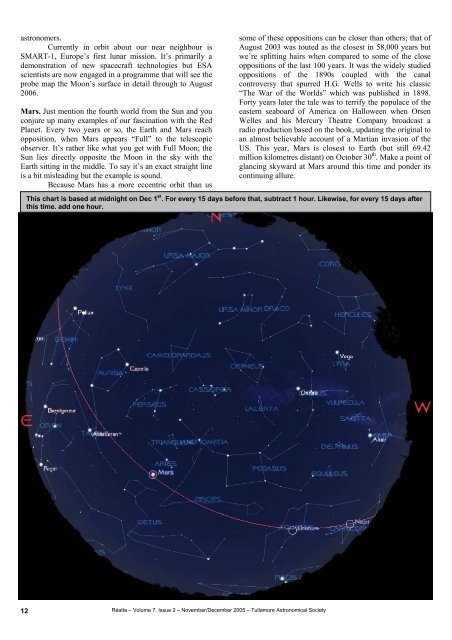Space - Tullamore Astronomical Society
Space - Tullamore Astronomical Society
Space - Tullamore Astronomical Society
You also want an ePaper? Increase the reach of your titles
YUMPU automatically turns print PDFs into web optimized ePapers that Google loves.
astronomers.<br />
Currently in orbit about our near neighbour is<br />
SMART-1, Europe’s first lunar mission. It’s primarily a<br />
demonstration of new spacecraft technologies but ESA<br />
scientists are now engaged in a programme that will see the<br />
probe map the Moon’s surface in detail through to August<br />
2006.<br />
Mars. Just mention the fourth world from the Sun and you<br />
conjure up many examples of our fascination with the Red<br />
Planet. Every two years or so, the Earth and Mars reach<br />
opposition, when Mars appears “Full” to the telescopic<br />
observer. It’s rather like what you get with Full Moon; the<br />
Sun lies directly opposite the Moon in the sky with the<br />
Earth sitting in the middle. To say it’s an exact straight line<br />
is a bit misleading but the example is sound.<br />
Because Mars has a more eccentric orbit than us<br />
some of these oppositions can be closer than others; that of<br />
August 2003 was touted as the closest in 58,000 years but<br />
we’re splitting hairs when compared to some of the close<br />
oppositions of the last 100 years. It was the widely studied<br />
oppositions of the 1890s coupled with the canal<br />
controversy that spurred H.G. Wells to write his classic<br />
“The War of the Worlds” which was published in 1898.<br />
Forty years later the tale was to terrify the populace of the<br />
eastern seaboard of America on Halloween when Orsen<br />
Welles and his Mercury Theatre Company broadcast a<br />
radio production based on the book, updating the original to<br />
an almost believable account of a Martian invasion of the<br />
US. This year, Mars is closest to Earth (but still 69.42<br />
million kilometres distant) on October 30 th . Make a point of<br />
glancing skyward at Mars around this time and ponder its<br />
continuing allure.<br />
This chart is based at midnight on Dec 1 st . For every 15 days before that, subtract 1 hour. Likewise, for every 15 days after<br />
this time, add one hour.<br />
12<br />
Réalta – Volume 7, Issue 2 – November/December 2005 – <strong>Tullamore</strong> <strong>Astronomical</strong> <strong>Society</strong>


